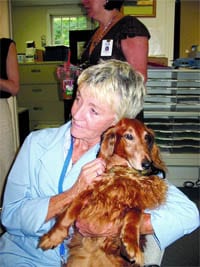Creature Comforts Dogs Can Forge Surprising Connections with Dementia Patients
When Leslie Prouty met KC, the 10-year-old dachshund was in the care of a rescue group, recovering from mistreatment at the hands of his former owners.
Having owned dachshunds all her life, including one that was paralyzed from the waist down, Prouty wasn’t afraid to take on another special-needs dog. But her affections were tested early on.
“Two or three days after I got him, he collapsed in the yard, paralyzed” she said. KC’s vet found severely damaged discs in his vertebrae and told Leslie that surgery — at a cost of $5,000 — was no guarantee of recovery.
“I had to make a decision, knowing there was a 50-50 chance he’d ever walk again,” she said. “But I’d had a dachshund before who had only had use of his front legs, so I took the chance. Well, within a week he was walking. It was miraculous.”
Today, plenty of men and women are glad that Prouty — with the help of Almost Home Dachshund Rescue Society, which picked up half the surgery tab — took that chance. Today, the dog is a beloved part of the staff at Beacon Hospice on Cape Cod, working as a therapy animal for people with end-stage dementia.
Soon after KC’s surgery, Prouty decided to volunteer her time at Beacon, helping to provide comfort and end-of-life services to terminally ill patients at nursing homes, assisted-living facilities, and their homes.
During her training classes, she learned about the soothing power than dogs seem to have on hospice patients, particularly those with end-stage dementia, who are often not responsive to other people. She immediately thought KC would be ideal for that kind of work, so she enrolled him — and herself — in an additional training course.
“He is an extremely different type of dog,” Prouty said. “He’s very, very mellow, and nothing bothers him. He doesn’t mind loud noises, but he doesn’t bark, so he’s better with people than other dogs.
“He looks right in your eyes,” she continued. “And these end-stage dementia patients — some more lucid than others — love touching him, and they want to look into his eyes, too. It’s mystical, almost.”
If that sounds a bit New Age-y, it’s not odd at all to those who actually facilitate encounters between therapy dogs and hospice patients.
“In many ways, end-stage dementia patients are forgotten by the medical community,” said Cindy Robotham, volunteer coordinator for Beacon’s Hyannis office. “They’re in custodial care, but they’re still alive. They may have trouble remembering, and their verbal skills deteriorate, but they still feel.”
She noted that one of the last senses to go is hearing, which is why Beacon uses music to reach its patients; some who almost never talk might start singing along to a song they recognize from their past. In the same way, she said, the dog helps forge a connection.
“He looks into their eyes, and they reach out to touch the fur, and that softness awakens something in them,” Cindy said. “And it’s definitely a palliative measure, giving patients the comfort we try so hard to bring them.”
Trained for Service
Specifically, KC works in Beacon’s Deep Harbors program, a first-of-its-kind research-based endeavor designed for end-stage dementia patients. Beacon has offices across Massachusetts, including one in Springfield, and Robotham would like to see the dog-therapy outreach expanded to all of them.
She comes armed with stories to explain why. One patient KC visited, she recalled, was usually unresponsive and highly agitated. When KC was placed in her lap, she immediately became calm and began stroking the dog’s fur.
“The touch of the dog was clearly therapeutic to her and put her at ease,” she said. “Her positive reaction to KC even prompted her to respond to questions and comments, something that was also highly unusual.”
But not just any dog can interact with dementia patients in this way. “People will speak very strongly about their dog,” Robotham said. “They’ll say, ‘my dog Rover is great with people.’ And Rover is probably a very good dog, bouncy and happy. But that’s not a therapy dog.”
The ideal hospice dog needs to be friendly, but mellow of temperament, she said, and focused on the needs of the people he’s visiting. And that takes training.
“It’s not just ‘sit’ and ‘stay,’” Prouty said. “One of the challenges was walking the dog up and down the aisles of PetSmart and teaching him to ignore things, like if someone drops a piece of food. A lot of dogs are like, ‘give me that scrap,’ but he has to be very good at not letting anything distract him. And he has to have a very gentle temperament.”
With success stories like KC in mind, Beacon is training other dogs, such as Monty, a basset hound owned by John Mercier, who connects with patients through the system’s Beverly office.
“I can’t say enough about my volunteers,” Robotham said, praising people willing to give their time to comfort the dying, with or without dogs. “No hospice can exist without a volunteer component.”
Other facilities are embracing the therapeutic abilities of dogs, too. Spectrum Home Health and Hospice Care, a program of Jewish Geriatric Services in Longmeadow, will also begin using therapy dogs as part of end-of-life care. The health system recently procured a donation from the Albert E. & Lillian M. Marceau Fund for the Terminally Ill and will use part of those funds to launch the program, which will employ Bright Spot Therapy Dogs of Westhampton to train the canines and their handler-owners.
“For patients in a nursing home or living at home, the unconditional love and acceptance provided by a dog really enhances people’s lives,” said Diane Mintz, vice president of Spectrum. “It’s been clinically proven that petting, touching, and talking to animals is very therapeutic. We feel like, at the end of life, this would be a good way to calm people and bring them joy. That’s why we applied for this grant.”
End of the Road
To those who have witnessed the effects of pet therapy, particularly with end-stage dementia patients, there’s no question as to its benefits, as long as the animal is the right match for the care setting, and well-trained.
“Sometimes people are depressed because they’ve had to give up a dog or a cat,” Prouty said, but that affection can’t be replaced by an overly exuberant animal. “These patients are fragile, so you can’t have a dog jump up onto them. They’re trained to know instinctively that someone is fragile, and they have to be gentle, quiet, and caring. That’s the way KC is.”
In addition, KC awakens a little bit of the past in patients struggling to hang onto their world, she noted. “When he visits, people are floating around in their wheelchairs, and some think it’s their dog. They’re like, ‘thank you for bringing my dog in.’”
For a moment, that connection can be enough to foster a more lucid day.
“He’s here for a special purpose,” Robotham said, “and Leslie, to her credit, instinctively knew it.”
Even though couldn’t have foreseen it at the time, that’s why she saved the life of a dog she hardly knew: so he could bring comfort to people nearing the end of their own.



Comments are closed.